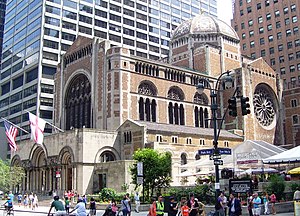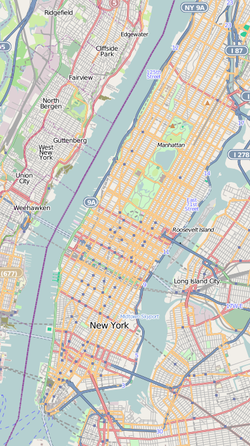Saint Bartholomew's Episcopal Church, New York
|
St. Bartholomew's Church
and Community House |
|

(2012)
|
|
| Location | 109 E. 50th St. Manhattan, New York City |
|---|---|
| Coordinates | 40°45′26″N 73°58′25″W / 40.75722°N 73.97361°WCoordinates: 40°45′26″N 73°58′25″W / 40.75722°N 73.97361°W |
| Area | 1 acre (0.40 ha) |
| Built | 1903 |
| Architect |
Bertram Goodhue McKim, Mead & White |
| Architectural style | Romanesque Revival, Byzantine Revival |
| NRHP reference # | 80002719 |
| Significant dates | |
| Added to NRHP | April 16, 1980 |
| Designated NHL | October 31, 2016 |
| Designated NYCL | March 16, 1967 |
St. Bartholomew's Church, commonly called St. Bart's, is a historic Episcopal parish founded in January 1835, and located on the east side of Park Avenue between 50th and 51st Street in Midtown Manhattan, in New York City.
On October 31, 2016, the St. Bartholomew's Church and Community House complex was designated a National Historic Landmark.
The congregation's first location was opened for service in January 1835, in a plain church at the corner of Great Jones Street and fashionable Lafayette Place.
The second location, built from 1872 to 1876 at the southwest corner of Madison Avenue and East 44th Street, was designed by James Renwick, the architect of St. Patrick’s Cathedral, in the Lombardic style. The building was embellished in 1902–1903 with a triple French Romanesque Revival portal by Stanford White, who took as his inspiration the church of Saint-Gilles, Gard, between Arles and Nîmes, which White had admired in 1878; the sculptures in the tympana are Renaissance-inspired. The portal was paid for by the family of Cornelius Vanderbilt II as a memorial; Vanderbilt's father, William H. Vanderbilt, had sold the site to the church. The magnificent bronze doors, with bas-reliefs in panels depicting episodes from the Old and New Testaments, were carried out by some of New York's established sculptors: Andrew O'Connor, working freely under the general direction of Daniel Chester French, executed the main door; the south door was executed by Herbert Adams, the north door by Philip Martiny.
...
Wikipedia



